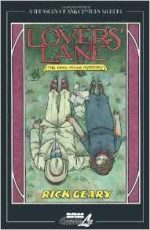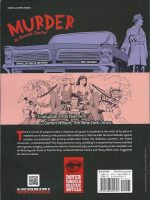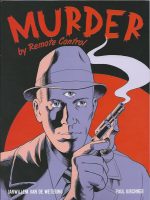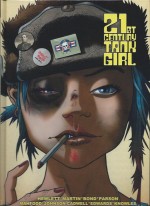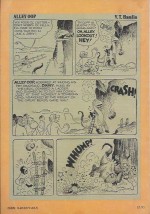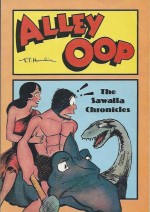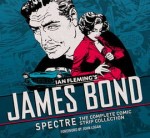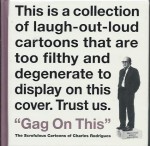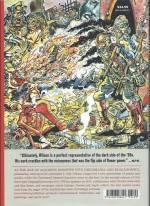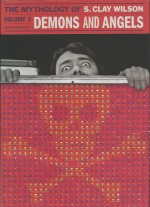
By V.T. Hamlin (IDW/Library of American Comics)
ISBN: 978-1-61377-829-6
Win’s Christmas Gift Recommendation: Primal Cartoon Fun… 10/10
Modern comics evolved from newspaper comic strips. These pictorial features were, until relatively recently, extremely popular with the public and highly valued by publishers who used them as a powerful weapon to guarantee and even increase circulation and profits. From the earliest days humour was paramount; hence our umbrella terms “Funnies†and of course “comicsâ€.
Despite the odd ancestor or precedent like Roy Crane’s Wash Tubbs (comedic when it began in 1924; gradually moving from mock-heroics to light-action into full-blown adventure with the introduction of Captain Easy in 1929) or Tarzan and Buck Rogers – which both debuted January 7th 1929 as adaptations of pre-existing prose properties – the vast bulk of strips produced were generally feel-good humour strips with the occasional child-oriented fantasy.
This abruptly changed in the 1930s when an explosion of rollicking drama strips were launched with astounding rapidity. Not only features but actual genres were created in that decade which still impact on not just today’s comicbooks but all our popular fiction.
Another infinitely deep well of fascination for humans is cavemen and dinosaurs. During that distant heyday of America’s strip-surge a rather unique real character created a rather unique and paradoxical cartoon character: at once both adventurous and comedic; simultaneously forward-looking and fantastically “retro†in the same engagingly rendered package…
Vincent Trout Hamlin was born in 1900 and did many things before settling as a cartoonist. After mustering out of the US Expeditionary Force at the end of the Great War V.T. finished High School and then went to the University of Missouri. This was in 1920 and he studied journalism but, since he’d always loved drawing, the eager beaver took advantage of the institution’s art courses too.
Hamlin was always a supreme storyteller and lived long enough to give plenty of interviews and accounts – many impishly contradictory – about the birth of his antediluvian archetype…
As a press photographer Hamlin had roamed the Lone Star State filming the beginnings of the petroleum industry and caught the bug for finding fossils. Whilst drawing ads for a Texas Oil company, he became further fascinated with bones and rocks as he struggled to create a strip which would provide his family with a regular income…
When V.T. resolve to chance his arm at the booming comic strip business, those fossil fragments got his imagination percolating and he came up with a perfect set-up for action, adventure, big laughs and even a healthy dose of social satire…
Alley Oop is a Neanderthal (-ish) caveman inhabiting a lush, fantastic land where dinosaurs still thrive. In fact his greatest friend and boon companion is Dinny; a faithful, valiant saurian chum who terrifies every other dinosaur in creation… as well as all the annoying spear-waving bipeds swarming about.
Because Dinny is as smart and obedient as a dog, all the other cave folk – like arrogant, insecure King Guzzle – generally treat the mighty, free-thinking, disrespectful Oop with immense caution…
Unlike most of his audience, Hamlin knew such things could never have occurred but didn’t much care: the set-up was too sweet to waste and it would prove to be the very least of the supremely imaginative creative anachronisms he and his brilliant wife Dorothy would concoct as the strip grew in scope and popularity.
Oop actually launched twice. In 1930 Hamlin whipped up primeval prototype Oop the Mighty which he then radically retooled and sold to small, local Bonnet-Brown Syndicate as Alley Oop. It debuted on December 5th 1932 and was steadily gaining traction when Bonnet-Brown foundered in the worst days of the Great Depression a year later.
Happily the strip had won enough of a popular following that the Newspaper Enterprise Association syndicate – whose other properties included Major Hoople, Boots and Her Buddies and the aforementioned Wash Tubbs – tracked down the neophyte scribbler and offered him a regular slot in papers all over America.
Alley Oop re-debuted as a daily strip on August 7th 1933, swiftly reprising his old stories for a far larger audience before moving on to new adventures and inevitably winning a Sunday colour page on September 9th 1934, the year V.T., Dorothy and new daughter Theodora relocated to affluent Sarasota, Florida.
Sadly for such a revered series with a huge pedigree – still running today scripted by Carole Bender and drawn by her husband Jack as both Sunday and daily feature – there has never been a concerted effort to properly collect the entire epic. There have however been tantalising outbursts of reprints in magazines and short sets of archive editions from Kitchen Sink, Dark Horse and IDW’s Library of American Comics.
This uniquely intriguing monochrome hardback (Part of The Library of American Comics Essentials range) re-presents – in the form of one day per elongated landscape page – the absolutely most crucial and game-changing sequence in the strip’s 80-year history as the protagonists escaped their antediluvian environs for the first time and were calamitously catapulted into the 20th century…
Supplementing the cartoon bedazzlement is a superbly informative and candid-picture packed introduction by Michael H. Price. ‘V.T. Hamlin and the Road to Moo’ reviews the creator’s amazing life and other strip endeavours before starting his life’s work and what the feature meant to him, after which the grand adventure – spanning Monday March 6th 1939 to Saturday March 23rd 1940 – opens in a strange land a long, long way from here and now…
A little background: the cave-folk of that far-ago time lived in a rocky village ruled over by devious, semi-paranoid King Guzzle and his formidable, achingly status-conscious wife Queen Umpateedle. The kingdom was known as Moo and the elite ruling couple were guided, advised and manipulated in equal amounts by the sneaky shaman Grand Wizer. All three constantly sought to curb the excesses of a rebelliously independent, instinctively democratic kibitzer and free-spirit Oop.
Our hero – the toughest, most honest man in the land – had no time for the silly fripperies and dumb made-up rules of interfering civilisation, but he did usually give in to the stern glances and fierce admonishments of his long-suffering girl “companion†Ooola. The uneasy balance of power in the kingdom comes from the fact that Guz and the Wizer – even with the entire nation behind them – were never a match for Oop and Dinny when they got mad… which was pretty often…
The big change began when Dinny turned up with an egg and became broody and uncooperative. With Oop’s mighty pal out of sorts, the Wizer then played a cruel master-stoke and declared that only the contents of the egg could cure King Guz of a mystery ailment and prompted a mini civil war…
After revolution and counterrevolution Oop and Ooola are on the run when they encounter a bizarre object which vanishes before their eyes. As they stare in stupefaction they are ambushed by Guz’s men and only escape because they too fade from sight…
Somewhere in rural America in 1939, brilliant researcher Dr. Elbert Wonmug (that’s a really convoluted but clever pun) discusses with his assistant the movies their camera took when they sent it into the distant past via their experimental time machine…
The heated debate about the strangely beautiful and modern-looking cave woman and her monstrously odd-looking mate are soon curtailed as the subjects actually materialise in the room and the absentminded professor realises he left his chronal scoop running…
Before he can reverse his mistake and return the unwilling, unwitting guests to their point of origin, the colossal mechanism catastrophically explodes, wrecking the lab and burying the astounded antediluvians in rubble.
Thanks to an unexplained quirk of temporal trans-placement, time travellers always speak the language of wherever they’ve fetched up – albeit through their own slang and idiom – so after Oop digs his way out utterly unharmed, explanations are soon forthcoming from the modern tinkerers. Before long the cave folk are welcomed to all the fabulous advances of the 20th century…
At least Ooola is – thanks to the friendly advice of Wonmug’s daughter Dee – but the hulking male primitive is quickly getting fed up with this fragile place, all snarled up with just as many foolish rules and customs as home…
Storming off to catch and eat something he understands, Oop is suddenly whisked across country in a spectacular and hilarious rampage of destruction – in the best silent movie chase tradition – after he falls asleep in a transcontinental freight train. After weeks of wondering Wonmug and the now thoroughly-acclimated Ooola read newspaper reports of a cunning and destructive “Great White Ape†and make plans to fetch their stray home. The government meanwhile have put top agent G.I.Tum on the case…
The Phantom Ape however has plans of his own and, after “trapping†an aeroplane and its pilot, makes his own tempestuous way back to the isolated lab.
Eventually the whole story comes out and the displaced cave-folk become media sensations just as Wonmug finally completes his repairs to the time machine. Sadly Ooola – and to a lesser extent Alley – are not keen on returning to their dangerous point of origin…
Moreover, not everybody believes Elbert has actually cracked the time barrier and the next segment sees scientific sceptic Dr. Bronson demand first hand proof. However when he eagerly zips off to experience Moo first hand he disappears and – after much pleading – Oop is convinced to follow him and find out what happened…
When the swirling sensation ends our hirsute hero discovers what the problem is: the machine is by no means accurate and its focus has shifted. He has rematerialised outside a gigantic walled city of what we’d call the Bronze Age…
What follows is a stupendous romp of action, adventure and laughs as Oop and Bronson become improbable and forgotten heroes of the Trojan War, meeting and enchanting Helen of Troy and becoming the embattled city’s top warrior generals.
In the 20th century Wonmug is arrested for murder. Dee and his assistant Jon struggle to perfect the machine but in the end resort to busting the genius out to fix the problem and bring the time-lost wanderers back. In a race against time that’s all soon sorted and Ooola heads for ancient Greece to save the lost boys.
Unfortunately she’s picked up by the besieging Greeks and, thanks to her skill with guns, mistaken for the goddess Minerva…
The legendary story further unfolds with Oop and Ooola on opposite sides until wily Bronson makes a breakthrough based on his historical knowledge and they all return home in time to save Wonmug from the cops…
Soon a compact time team is established to exploit the invention – but not before Oop returns to devastated Troy to retrieve his beloved stone axe and – with Bronson and Ooola in tow – finds himself swept up in little sea voyage we knows as the Odyssey…
Back in America the team expands after old college chum and genius of all knowledge G. Oscar Boom invites himself to Wonmug’s scientific party. With all contact lost the unscrupulous rogue offers to go looking for them in the untrammelled past, providing he can take his specially tricked-out station wagon…
As this stunning collection concludes Boom and a mighty hitchhiker named Hercules have just run into the missing chrononauts as they are about to enter the Amazonian wilds of the Land of Warrior Women…
To Be (hopefully) Continued…
Having escaped the ultimately limiting confines of the strip and becoming a seasoned time travellers Hamlin had made the best of all worlds for his characters: Oop and Ooola periodically returned home to Dinny and the cave folk of Moo but they also roamed every intriguing nook and cranny of history ands even escaped planet Earth entirely and hopefully our own future holds the prospect of more such splendid strip sagas…
Fast-paced, furious, fantastically funny and bitterly barbed in the wryly acerbic manner of Billy Wilder and Preston Sturges, Alley Oop is a bone fide classic of strip narrative, long overdue the respect and honour of a complete chronological collection.
However until some enlightened publisher gets around to it, by all means start digging on line and in bargain bins for each – or any – of the wonderful tomes already released. It’s barely the tip of an iceberg but it’s a start…
Alley Oop © and ® 2013 United Features Syndicate, Inc. All rights reserved.
